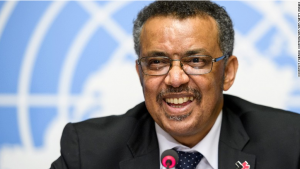Neil Sircar, J.D., is an LL.M Candidate in Global Health Law at Georgetown University Law Center & the O’Neill Institute for National and Global Health Law..
Dr. Tedros, the newly-minted Director-General of the World Health Organization, has made human rights and health one of if not the primary framings for how he will guide WHO over his tenure. However, the reality has long been that health and human rights are often icing on a cake for health system strengthening: sugary and sweet but not the substance that gets baked. Dr. Tedros is cognizant of this situation, stating that “When it comes to rights issues in the reform, importantly, it’s not so much the design of the processes or structures that will make a difference. Far more important is ensuring that health as a human right is engrained into the mindset and attitudes of staff.”
So, how do we measure success in human rights and health? The human rights-based approach (HRBA) a process that for years health advocates have looked to in integrating human rights into programming, and HRBA certainly is a good vehicle in its many iterations for that. But, HRBA remains half-baked (to use the previous metaphor) when it comes to evaluating positive health outcomes resulting from a health-and-human-rights intervention. Many contemporary programs include HRBA or human rights-oriented framing but there is little clear evidence of follow-through or impact; indeed, HRBA may not have been a priority for programs beyond engrained mindsets. Where there are positive claims of successful human rights interventions we lack critical analysis of those claims, their replicability in other contexts, and how big an impact they made. By no means is this posting a critique of those efforts, but rather what I draw attention to is that having the right words on paper or on the minds of global health actors is not enough: we need to know what human rights interventions for health work, when they work, and how to both design and evaluate them.
Some in WHO are already thinking on how to go from concepts to projects and programs, remaining cognizant of the challenges that come from measuring a spectrum of change. Health outcomes are the result of multiple factors, so HRBA may impact any or all of the factors contributing to health and be successful or not. We will not know though unless our interventions are designed to be measurable. Heretofore many study designs have not been structured substantively enough to allow for careful analysis of a particular human rights intervention’s health impact, or are designed in such a way that the impact of particular interventions are difficult to accurately assess. As a consequence, the designers of future HRBA and human rights interventions cannot determine which interventions work best in which contexts. They may not even know where to begin in designing a program or project, even if acting on a well-drafted guidance document or tool.
Human rights in health are a critically important field, and there are plenty of spaces to develop HRBA within global health governance and local health programming. WHO and Dr. Tedros are not alone in seeking to instill a greater modus operandi in their operations and those of their partners. My suggestion: in addition to engraining human rights into the minds of WHO staffers, WHO and other global health actors should develop measurable, evidence-generating interventions that can show the links between greater human rights realization and positive health outcomes, as we must bake-in HRBA to what is being done, not just what is on the minds of those doing something.




